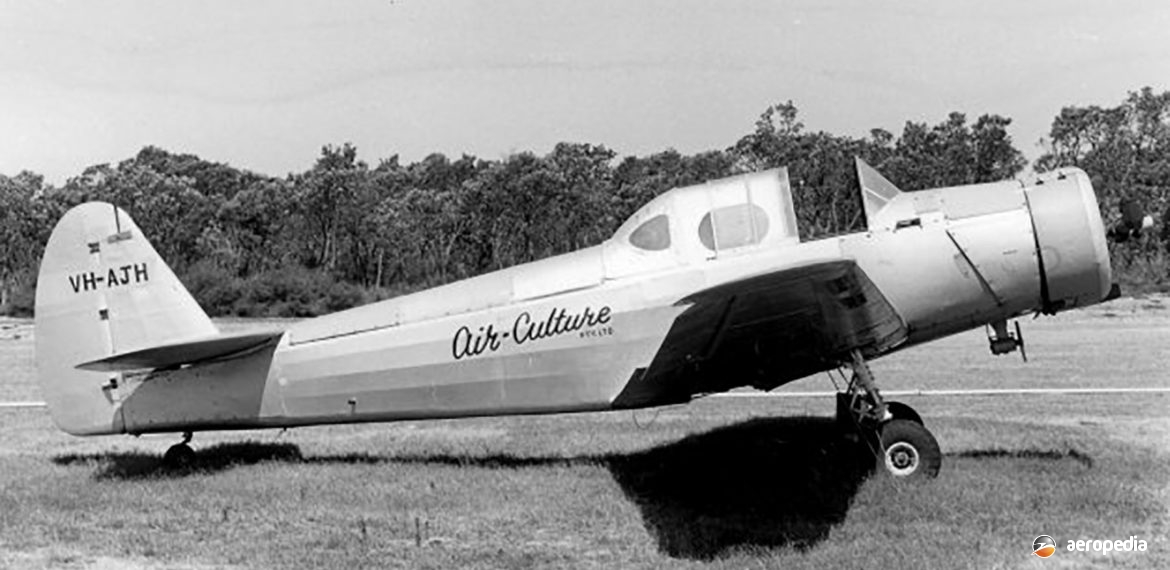Photograph:
Kingsford Smith KS-3 VH-AJH (c/n 283) operating in Western Australia (Geoff Goodall)
Country of origin:
Australia
Description:
Single-seat agricultural monoplane
Power Plant:
One 131 kw (175 hp) Warner Super Scarab 165D seven-cylinder air-cooled radial engine
Specifications:
- Wingspan: 11.28 m (37 ft)
- Length: 7.93 m (26 ft)
- Height: 2.06 m (6 ft 9 in)
- Wing area: 17.09 m² (184 sq ft)
- Max speed at sea level: 177 km/h (110 mph)
- Cruising speed: 156 km/h (97 mph)
- Initial rate of climb: 213 m/min (700 ft/min)
- Service ceiling: 4,877 m (16,000 ft)
- Empty weight: 865 kg (1,906 lb)
- Loaded weight: 1,188 kg (2,620 lb)
History:
The KS-3 agricultural aircraft was the forerunner of the Yeoman Cropmaster, and was built at Bankstown, NSW, by Kingsford Smith Aviation Services (KSAS) in the 1950s. KSAS was well versed with the Wackett, having been involved in overhauling some 50 ex-RAAF Wacketts for the Netherlands East Indies Air Force (NEIAF) in 1946.
In 1957 KSAS modified a Wackett VH-AJB (c/n 274) to improve performance. In February 1957 further modifications were made and, following tests, another Wackett VH-AJH (c/n 283) was converted for agricultural use by the installation of a hopper in the front cockpit. First flight was made on 26 March 1957, and this aircraft, known as the KS-1, could carry a 295 kg (650 lb) payload.
In August 1957 further modifications were made, including a new hopper and louvre box, and the KS-1 became known as the KS-2. The Chief Pilot of Airwork Pty Ltd of Perth, WA flew the aircraft and asked that the hopper be placed behind the pilot to improve visibility and for ease of loading, and a Wackett (c/n 363) was so converted.
Following initial use of the aircraft for a period as noted, this Company recommended changes to the conversion to make it more suitable in its design role. The result was the KS-3, which had a completely re-designed fuselage and a modified wing. The hopper was placed in a hole cut out of the centre-section of the wooden wing, and the control system was re-designed to bypass the hopper, which was installed in what was previously the rear cockpit, which had a capacity of 13 m³/364 litres (459 sq ft/80 Imp gals) and was built of aluminium.
Another Wackett VH-FBD¹ (c/n 299) was converted but this aircraft, along with the prototype PL-7 Tanker, was destroyed in a hangar fire at Bankstown on 17 January 1958. KSAS then reserved registrations VH-FBD to VH-FBM for the first production batch of ten aircraft. Another KS-3 VH-FBE (c/n 365) was completed and flown on 24 December 1957.
A fourth Wackett (c/n 410) was converted, being test flown and registered on 27 June 1958, becoming VH-FBD². Surplus equipment was removed and, despite the installation of the 123 kw (165 hp) Warner Super Scarab engine, which was considered a little under-powered for this role, the aircraft was found to have a reasonable performance.
First customer delivery was VH-FBF (c/n 375) to Airwork in Western Australia, this aircraft having been slightly damaged in the hangar fire referred to but, being repaired, flying for the first time on 21 February 1958. Later the KS-2 VH-AJH (c/n 283) was overhauled, brought up to KS-3 specifications, and bought by Airwork.
All KS-3 Cropmasters were operated by Air Culture Pty Ltd, having been obtained from Airwork, in association with Yeoman Aviation Pty Ltd of Claremont, WA, the aircraft being operated under the Yeoman Aviation airwork licence. In 1958 KSAS put to the Department a submission it would build an all-metal wing and tail for all future production aircraft, indicating it had orders for 12 aircraft at that time. It also proposed a tricycle undercarriage and installation of either a 179 kw (240 hp) Continental or a 201 kw (270 hp) Lycoming engine. In this regard Yeoman Aircraft was set up to build the new aircraft, and Yeoman later went on to develop and build the YA-1 Cropmaster, Air Culture being the major user.
Air Culture operated the KS-3s until May 1961 when legislation forced their retirement because of Departmental policy on plywood box-spar construction of wings. The aircraft were used extensively for dusting and spraying operations, as well as sowing wheat, and were the first aircraft in Australia to be used for this type of operation.
KS-3s built were: VH-FBD¹ (c/n 299) registered in December 1957, but destroyed in a hangar fire at Bankstown on 17 January 1958; VH-FBD² (c/n 410) registered on 27 June 1958 and wrecked when it ground looped at Borden, WA on 27 November 1961; VH-FBE (c/n 365) registered from December 1957 to May 1961; VH-FBF (c/n 375) registered from March 1958 to April 1961 when it crashed at Northampton, WA; and VH-AJH (c/n 283) which, after retirement from agricultural operations, was flown in the private category from May 1963 to April 1964. After having had its hopper removed and side windows fitted, it was stored for some years until placed on display at the Royal Australian Air Force (RAAF) Association Heritage Museum at Bull Creek in Perth, WA in 1976. In 2008 VH-AJH (ex A3-49) was obtained, and placed on display, by the Queensland Air Museum at Caloundra.

